In November 1945, UNESCO – the United Nations Educational, Scientific and Cultural Organization – was founded. On 16 November, 37 of 44 states present at the meeting held in London signed the Constitution of the organization. A year later, the Constitution entered into force after ratification by twenty states.
According to the Constitution, the main objectives of the organization are to contribute to peace and security by promoting cooperation between states and peoples in the fields of education, science and culture; to ensure justice and observance of the law; and to promote universal respect for human rights and fundamental freedoms for all peoples without distinction as to race, sex, language and religion.
Today, UNESCO consists of 195 states and the list of World Heritage Sites grows every year. This list includes not only tangible, architectural monuments and natural sites, but also written heritage, ancient traditional holidays and spiritual heritage of different peoples. Today, we invite you to take a look at some of the most striking architectural Islamic monuments that have become part of the world’s heritage.
Mausoleum of Khoja Ahmed Yasawi (Turkestan, Kazakhstan)
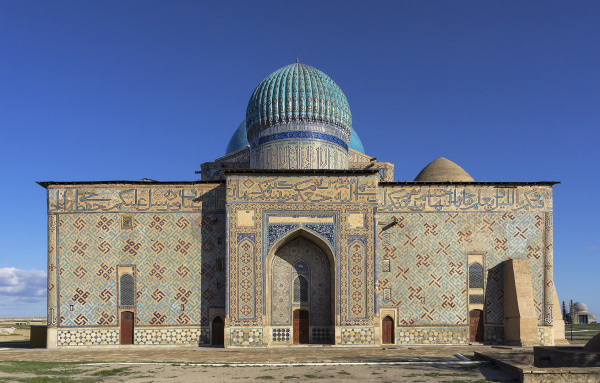
In Kazakhstan, there are plenty of cultural monuments and even entire cities that are several centuries old. The Mausoleum of Khoja Ahmed Yasawi is one of such unique historical artifacts. It is located in the ancient city of Turkestan (today’s cultural and spiritual capital of the republic).
The city of Turkestan was one of the junctions of the Great Silk Road. It was here that Khoja Ahmed Yasawi, a Sufi poet and philosopher, lived his life. His poems conveyed thoughts of goodness and honor to people. They were the poems that people learned by heart and passed down far beyond the hometown.
The construction of the Mausoleum of Khoja Ahmed Yasawi took place between 1385 and 1405 on the site where his modest tombstone used to be located, after Tamerlane’s victory over Khan Tokhtamysh, the ruler of the Golden Horde. The construction of the mausoleum involved innovative architectural solutions for its time, which were later used in the construction of Samarkand, the capital of the empire.
Over the period of two decades, an impressive complex emerged on this site, combining the functions of a mausoleum, mosque, khanqah and administrative and household premises. The construction of a Sufi monastery for Yasawi’s followers was also begun nearby, but Tamerlane’s death halted the construction.
During the time of the Kazakh Khanate, the building of Khoja Ahmed Yasawi Mausoleum and the surrounding structures served as Kazakh Khans’ residence. The mausoleum was surrounded by a strong wall, rampart and mound, which served to defend the complex, thus giving it the status of a fortress.
Nowadays, Khoja Ahmed Yasawi Memorial Complex is a giant rectangular building (46,5 x 65,5), decorated with portals and domes, one of which is the largest brick dome in Central Asia (its height is 44 m and diameter – 22 m). There are thirty-six different rooms and halls inside the mausoleum. First of all, this is the central hall, the walls of which are covered with blue tiles. There is a huge kazan (cauldron) of seven metal alloy with a diameter of 2,45 m and weighing about two tons in the central hall. It used to serve to feed people after Friday prayers. There is also an impressive bronze lamp from 1397, a gift from Tamerlane to the mausoleum.
There is also the tomb of Khoja Ahmed Yasawi, the door of which is decorated with ivory and wood carvings; the cell of the Sufi himself; the Great Palace with the Khan’s throne and scepter; the Small Palace, where the pantheon of Kazakh Khans (43 tombstones) is located; the Small Mosque, the main place of prayer; a library, as well as outbuildings, including a bathhouse with steam rooms, a well room and a dining room, where ancient cookers, a boiler, wooden utensils from which pilgrims ate and other ancient household items have been preserved.
Great Mosque and Hospital of Divrigi (Turkey)
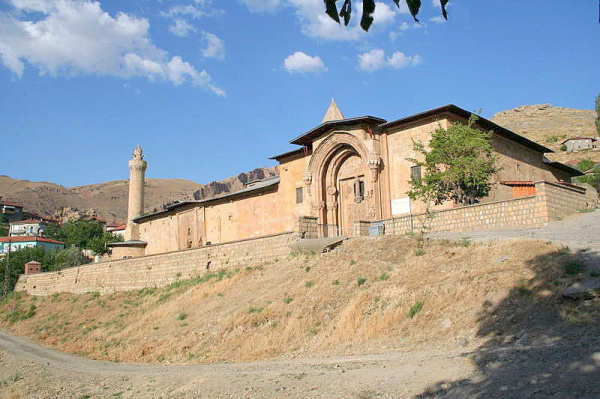
The city of Divrigi in Turkey is home to an architectural complex that was the first Islamic work of architecture on that land. It includes a cathedral mosque and a hospital.
The unique architecture of this building combines luxury and simplicity intertwined with each other. From the outside, the structure looks quite imposing: the large mosque, crowned by two domes, is marked by three imposing portals. Lavishly decorated with stone carvings, they are a major architectural treasure. The main entrance is decorated most of all: a number of patterns imitating vegetation form a special composition that encircles it. Unlike the entrances, the interior decoration of the mosque is very modest. Naves, a prayer hall and a stone vault lack any architectural extravagance.
The hospital adjoining the mosque is decorated with unusual ornaments and patterns carved in stone, while inside it is lined with columns with geometric motifs and a spiraling fountain, which is no longer functional today.
The Great Mosque and Hospital in Divrigi have become one of the most beautiful constructions, the appearance of which alone is a unique asset to the public.
Selimiye Mosque and its Social Complex (Turkey)
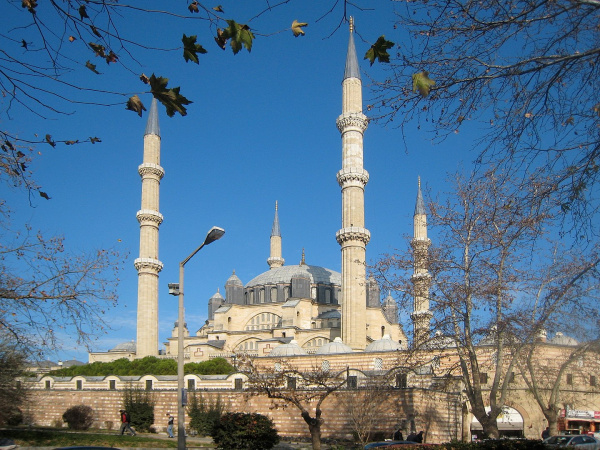
The Selimiye Mosque is one of the brightest examples of Islamic religious architecture from the time of the Ottoman Empire. It has a grand complex of outbuilding ranging from a madrasah to its own covered marketplace.
The Selimiye Mosque, built in the XVI century by order of Sultan Selim II, is considered to be the main symbol and iconic architectural masterpiece of the Turkish city of Edirne. The mosque, which stands on a steep sloping hill, has a square ground plan, a grand dome and four graceful minarets and is designed as a beacon for travelers approaching Edirne. Its most famous architect is great Sinan, the chief urban planner of the Ottoman Empire, who considered the Selimiye Mosque to be the best of his works until the end of his life.
While building the mosque, the architect was able to realize his long-held dream of setting an enormous dome on a regular octagon. The mosque dome reaches a diameter of thirty meters and stands forty meters high. It is decorated with floral ornaments dating back to the sixteenth century and is erected on eight two-meter high pylons, which are connected with each other by graceful arches. Together they form a rotunda which blends harmoniously into the geometry of the surrounding walls. The large number of windows cut directly into the dome gives the mosque building an amazing effect of spaciousness.
The interior of the mosque also deserves special attention. It is decorated with Iznik tiles which can be seen in the Sultan’s box and on the walls near the mihrab and minbar. The center of the prayer hall is decorated with a fountain and a wooden kyursyu built on small marble columns. The minarets of the mosque are up to seventy meters and each of them has three balconies to which internal staircases lead, isolated from each other.
It is worth noting that the original complex of the mosque included only two madrasah buildings constructed along with the mosque building in the XVI century. But later on, the internal area was supplemented with a covered market placed at the very entrance to the mosque courtyard; the building of the Quran recitation school; a clock-room and a library. Since 2011, the Selimiye Mosque, together with its complex of outbuildings, has been included in the UNESCO World Cultural Heritage list.
Jameh Mosque of Isfahan (Iran)
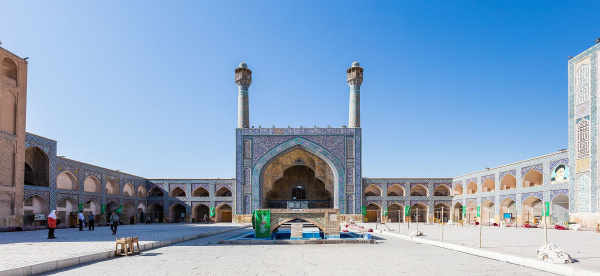
The Jameh Mosque (‘Friday Mosque’) in Isfahan is one of the most ancient mosques in Iran. It is truly an architectural masterpiece that has become a model for emulation. Inspired by this very mosque, religious buildings began to appear all over the Muslim world from the XII century onwards. Moreover, it is said that it was the brick nervures of Jameh’s domes that inspired architects to use fan-shaped Gothic vaults of Christian churches. The mosque has long been a place of worship not only for Muslim believers, but also for all lovers of the beautiful, so it is worth visiting.
The construction of the Friday Mosque took many centuries – the foundation was laid around 771, but it was reconstructed and expanded until the end of the XX century. One of Iran’s most ancient religious buildings was constructed in the Seljuk architectural style of “four iwans”, that is, four gates facing each other.
During the rule of the Seljuk dynasty, two brick domed sections were completed. The southern dome was built in 1086-1087 to house the mihrab and was larger than any other mosque dome in the world built by that time. The northern dome was built a year later; its purpose is unknown.
In the IX century, when Isfahan became part of the Islamic Caliphate, the Abbasid rulers rebuilt the mosque, adding square brick columns all around.
Another major renovation of the building took place in the XI century, during the reign of Seljuk Caliph Malik Shah. It was the vizier of Malik Shah, Nizam al-Mulk, who is credited to as the chief architect of the Jameh Mosque. He added a large brick dome to the mosque in front of the mihrab, to which the very iwan led. Such an elegant combination was a new word in mosque construction, despite the fact that it conformed to all the strict canons and traditions of ancient Sassanid architecture.
The second dome of the Jameh Mosque was erected much later by al-Mulk’s rival and it is the one that survived in its original form after the fire of 1120. After the fire, the mosque was restored and completed. The emergence of four iwans facilitated the addition of separate buildings on each side of the mosque, marking the beginning of madrasahs.
Prophet Ibrahim Mosque in Al-Khalil (Palestine)
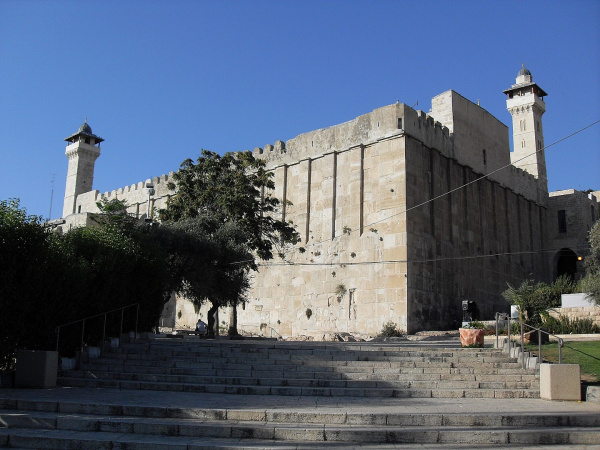
The Mosque of Ibrahim in Hebron (also known as Sanctuary of Abraham) is erected on top of a cave, believed to contain the tombs of the Prophet and his family. The building was initially constructed by King Herod at the end of the first century BC – on the site of the cave – and featured huge stone walls. In about 635-637 AD a mosque was built on this site, making it one of the most ancient Muslim temples in Palestine and entire Levant. The Ibrahimi Mosque is considered to be the fourth most important Muslim shrine after Mecca, Medina and Al-Haram Al-Sharif in Jerusalem.
The Prophet’s burials in the cave were so revered that Muslims did not enter it. The mosque contains six cenotaphs – of Prophet Ibrahim and others. Before the Crusaders captured it in 1099 and turned it into a church, the Ibrahimi Mosque underwent some alterations by the Muslim rulers, including construction of stairs at the entrance.
Once Saladin conquered the city in 1187, the building was returned to its original function as a mosque, although Christians retained the right to pray here for several years. Then the ruler at that time ordered to build a minaret on each corner of the mosque, of which only two have survived to these day, and a beautiful minbar, which originally adorned Ascalon’s main mosque until 1191.
During the reign of the Muslim Mamluk Dynasty, the upper part of the walls of the mosque was further decorated; two more entrances were built, as well as six cenotaphs, which are still standing today. They are dedicated to Prophets Ibrahim, Yaqub, Ishaq and their spouses, and are covered with green tapestries richly decorated with ayats from the Quran.
Under the Ayyubids and the Mamluks the city became the center of learning and was home for some Sufi orders. During the time of the Ottoman Empire, a lot of pilgrims came here and it became a tradition to feed free lentil soup to all residents and visitors every day. This treat was called ‘adas al-Khalil’ and was given out to commemorate legendary generosity of Prophet Ibrahim. It is known that in those days houses were built without kitchens, since people got used to rely on that treat.
Hebron (or Al-Khalil) is the largest city in the West Bank, with a predominantly Palestinian population and with about 400-500 Israeli settlers living in the Old Quarter. Today, the Ibrahimi Mosque is divided by a wall and one part of the building is turned into a synagogue where Jewish services are held. Since the mosque is located in the Old City, which is an Israeli security zone, Palestinian population has no access to it.
Sultanahmet Mosque (Turkey)
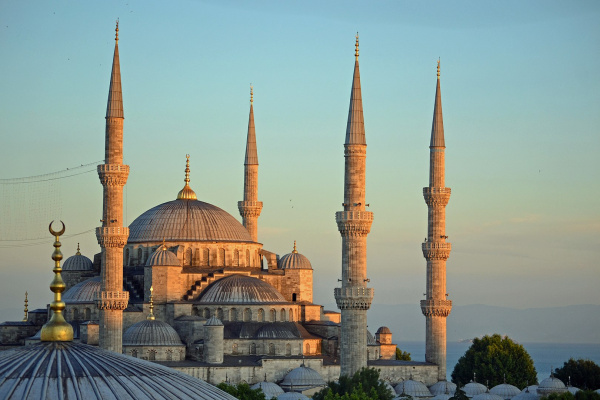
The Sultanahmet Mosque (‘the Blue Mosque’) is the second large mosque after the Selimiye Mosque and one of the most beautiful mosques in Istanbul. The mosque has six minarets: four on the sides and two more slightly lower ones on the outer corners. It is considered to be one of the greatest masterpieces of Islamic and world architecture. The mosque is located on the banks of the Sea of Marmara in the historic center of Istanbul in the Sultanahmet district.
The mosque was built during the reign of Sultan Ahmed I in 1609. The architect of the mosque is well-known Sinan’s disciple, Sedefkar Mehmet Agha, who decided to surpass his teacher. The construction of the mosque took seven years and was completed in 1616, a year before the Sultan’s death. The mosque received its name ‘Blue Mosque’ because of the huge number (over 20 000) white and blue handmade Iznik ceramic tiles used in the interior decoration. Plant motives, traditional for Turks tulips, lilies, carnations and roses, and also ornaments of different colors on white background dominate in the patterns of the mosque. The floor of the mosque is carpeted.
The mosque was built as part of a large architectural complex which included: a madrasah, a hospital, charitable institutions, kitchens and caravanserai. In the XIX century the hospital and the caravanserai were destroyed. There is a mausoleum next to the mosque, where Ahmed I is buried.
Hagia Sophia in Istanbul (Turkey)
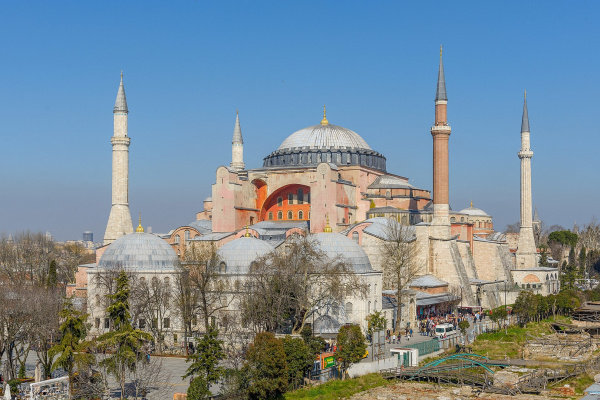
In the early days, the temple of the pagan goddess Artemis stood where the Hagia Sophia is located now, until 360. Then the Roman Emperor Constantine I built a small Church of St. Sophia here. Until 380 the temple was owned by the followers of Arianism, one of the earliest currents in Christianity, after which the cathedral passed into hands of the Nikenians – at the behest of Emperor Theodosius I.
In 1054, St. Sophia Cathedral went down in the history of world Christianity as the place where the split of churches into Orthodox and Catholic divisions was initiated. The last Christian service in the history of St. Sophia was held at night on May 28, 1453. The next day the temple was seized by the Turks. On 30 May Mehmed II, the Sultan of the Ottoman Empire, entered the main temple of defeated Byzantine. The Turks did not destroy the building itself. Having attached four minarets, they turned it into a mosque and called it Hagia Sophia. In the second half of the XVI century buttresses were added to the formal cathedral – vertical constructions, very heavy and rough, intended for strengthening the walls. These constructions considerably changed the appearance of the mosque. As for the interior, the frescos and mosaics were plastered over, apparently to make them less reminiscent of its orthodox past. The restoration of Hagia Sophia did not take place until the middle of the XIX century, when it was ordered by Sultan Abdul-Medjid I due to the danger of collapse. The restoration works began in 1847 and lasted two years.
After the defeat of the Ottoman Empire in the World War I, the monarchy was abolished and the Republic of Turkey was proclaimed on November 2, 1922. It was not until 1935 that the new authorities decided the fate of this amazing historical, religious and architectural landmark. Kemal Ataturk, the Prime Minister, signed a decree making the mosque a museum. In order to fully comply with this status, the plaster layers on the mosaics and frescoes were peeled off. In 2006, a separate room was equipped in the building so that the staff of the museum complex could perform Muslim religious rituals.
In 2018, the Turkish Constitutional Court received a submission from a private organization specializing in historical monuments to return the status of a mosque to the Hagia Sophia. However, the judges rejected it as inadmissible. But two years later, the temple was returned to mosque status.
Ilmira Gafiyatullina
Photo: Creative Commons
